
For a few years now, tools have appeared on the market that allow you to measure speed and power components on resistance training movements. The enthusiasm generated by this type of device has become increasingly important, both in high-level sports and in common practice in resistance training. During my last year of master in Cardiff, I started to get interested in their use after a friend sent me an article on the subject. Subsequently, we published two research articles in the Journal of Strength and Conditioning Reasearch (JSCR), which allowed us to expand our knowledge of what is known in English as "Velocity Based Training" (VBT). The purpose of this review is to provide a detailed user guide for these velocity sensors for lifters, based on available scientific knowledge and my personal experience.
In the world of strength, the training periodization is traditionally based on percentages of 1RM, also called percentages of relative load. As a reminder, the 1RM corresponds to the maximum load with which an individual can perform an exercise, within a defined technical framework. However, even if this method of programming is proven, it still has some limitations inherent in its mode of operation. A first limitation of this method lies in its rigid way of considering human performance. Indeed, a periodization based on percentages of relative load does not take into account an essential reality of field : the human species, in its great genetic diversity, presents a large inter-individual variability of the physiological abilities of training adaptation (Hubal et al., 2005, Timmons, 2011). Considering this diversity involves individualizing the major variables of training such as frequency, volume and intensity of workouts, in order to optimize progression and limit the risk of overtraining. Traditional periodization also fails to take into account factors that are beyond the control of the physical trainer but that play a key role in achieving performance, such as sleep quality (Pilcher and Huffcutt, 1996), nutrition (Langfort et al., 1997) or even the mindset. This sometimes results in periodization errors, resulting in the prescription of loads too heavy or too light. In addition, 1RM testing is nervously stressful (Niewiadomski et al., 2008), especially for advanced lifters who, by their experience, are able to maximize central nervous system recruitment. Therefore, traditional periodization involves two antagonistic constraints, which are :
However, this lack of regulation can be offset using various methods of subjective intensity evaluation, with tools such as the Borg scale, repetition in reserve estimation (RIR), the modified Rated Perceived Exertion (RPE) scale of Mike Tuchscherer (Fig. 1).
Without going into the details concerning the use of such tools, these scales serve among other things to estimate the internal load in resistance training (Day et al., 2004, McGuigan et al., 2004, Zourdos et al., 2016) and thus to perform adjustments in the training variables. These subjective methods can be a relevant alternative to the use of traditional periodization alone, because they allow introducing some form of self-regulation in training. These scales of measurement are however not adapted to a beginner lifter (Zourdos et al., 2016), which does not yet make the link between certain interoceptive sensations and the corresponding level of fatigue. They are better adapted to more advanced lifters who, by their experience, have built themselves internal sensory cues allowing them to estimate the number of repetitions in reserve during the execution of one set. Thanks to these scales of subjective load assessments, it is therefore possible to adjust from one workout to another depending on the athlete's feedback, or to simplify the periodization of the assistance exercises. However, they quickly find their limits when programming the main exercises such as the squat, the bench press or the deadlift. It is indeed difficult, and in my opinion risky, to base its periodization entirely around this method, unless you have in front of you an athlete having a big experience in resistance training.
Example of traditional periodization :
This basic traditional programming format can be advantageously completed in the following way :
By doing so, several problems inherent in a type of periodization exclusively based on 1RM percentages are avoided : 1) the interindividual variability of the Load-RM relationship (Richens and Cleather, 2014), which corresponds to the maximum number of repetitions that it is possible to perform with a certain percentage of 1RM; and 2) the variability of fatigue levels. By including some self-regulation on the hardest series (supposedly the last series on a plateau format), we are able to regulate the overall volume of the session according to the fatigue of the day. Thus, the workout adapts to the abilities of the lifter, not the other way around. We can even envisage a progression centered on the evolution of the RIR level, in complement or in replacement of the traditional evolution of the work load. To use our example of the squat, this would give :
As you can see, the evolution of the intensity here was entirely replaced by a degressive evolution of the RIR level. For more information on subjective regulation methods, I invite you to read Yuri Verkhoshansky's book "Supertraining".
Having introduced the interest of introducing a part of self-regulation into the programming, let's see how the bar speed can be used as objective marker of the internal load.
There are some conditions to respect when you want to effectively integrate a velocity sensor into your training :
The intention of maximum speed is defined as the will to want to move a mass (here the system body / bar) as quickly as possible. However, we cannot be satisfied with this instruction alone. It is indeed imperative not to favour the intention of speed on the technique of execution. For example, it must always be ensured that the heels do not take off from the ground at the end of the movement during a squat or a deadlift, or do not compromise the fixation of the shoulders on the bench during the bench press. This instruction is also valid for certain aspects relating to the motion kinetics. On an exercise like the deadlift, it is necessary to exert a pre-tension on the bar, even before being able to generate the movement. This phase has the dual objective of finalizing the correct placement of body segments and recruiting a maximum of motor units before exercise. The intention of maximum speed does not apply to this initial. It will only apply to the portion of the concentric phase of the movement, as soon as the bar takes off from the ground. It is essential to always keep in mind this intention of maximum speed when integrating the principles of VBT, and for the following reason : the main objective of this method is to determine a work intensity, and to measure a fatigue level through the RIR. If the intention of speed is not maximal, then the difference between what has been done and what could have been produced in terms of speed of execution leads to misinterpretations. In practice, this would result in the prescription of a workload that is too low compared to the athlete's abilities, and / or an estimate of a lower RIR level than it actually is.
The training method that I describe here is based on the unique characteristics of the Load-Velocity relationship, common to all polyarticular movements in resistance training. The first principle to remember is that any increase in the workload necessarily leads to a linear decrease in the speed of execution (Bobbert, 2012, Cuk et al., 2014, Rahmani et al., 2001, Sheppard et al., 2008). This means that if you measure the speed of execution of an exercise over a wide range of different loads, each 20% of 1RM for example, the report of the points on a graph will present a good alignment (Fig. 2).
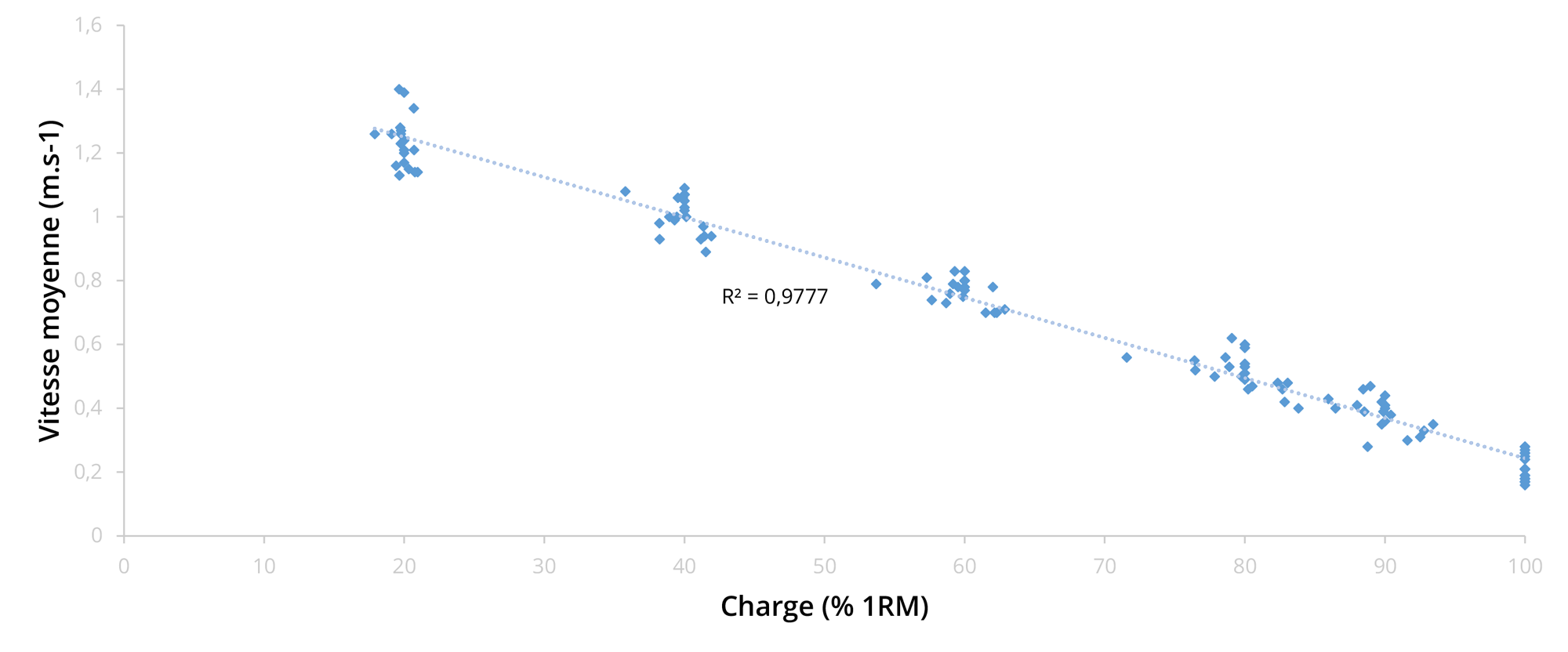
Figure 2. Relationship between the load (% 1RM) and the concentric mean velocity, obtained over 120 repetitions from 20 incremental tests during deadlift. The dotted line represents the linear regression (Chéry and Ruf, 2017).
The second characteristic of the Load-Velocity relationship that will be of interest for us is that in addition to being linear, this relation is stable in time. That is, if we take these same speeds for each percentage of 1RM tested, but let's say a year later, these relative speeds will have hardly changed ! Moreover, this stability in the Load-Velocity relationship remains true despite any increase or decrease in 1RM (González-Badillo and Sánchez-Medina, 2010, Sánchez-Moreno et al., 2017). As a result, whether you have gained or lost 30 kg on your 1RM, the speeds achieved at 40, 60 or 80% of your 1RM will remain virtually unchanged.
It is important to note, however, that intensities less than 40% 1RM and greater than 90% 1RM cannot be considered statistically reliable (Chéry and Ruf, 2017). This variability of speeds at intensities close to the 1RM, also observed by Banyard et al. (2017c), notably invalid the use of 1RM prediction equations from a Load-Velocity profile (Ruf et al., 2017, Banyard et al., 2017a) initially proposed by various studies (Bazuelo-Ruiz et al., 2015 ; Jidovtseff et al., 2011 ; Loturco et al., 2016 ; Loturco et al., 2017). This divergence in the conclusions of the studies, concerning the reliability of this method of predicting the 1RM is most probably explained by the intervention of various factors :
Considering this information, I do not advise the use of linear regressions for the purpose of predicting 1RM. As we will see, however, there are other ways to use the Load-Velocity profile information in training.
Studies show us that training with the intention of maximum speed, even at heavy load, allows physiological adaptations similar to those that could be expected from explosive training (Behm and Sale, 1993; Tillin and Folland, 2014; Young and Bilby, 1993; Kawamori and Newton, 2006), while benefiting from adaptations specific to heavy training. In sports science, nervous factors are differentiated from the structural factors of force (Cometti, 1989). Nerve factors include all mechanisms related to nerve control, while structural factors, they relate to the physiological mechanisms that occur locally in the muscles. With respect to nerve factors, training with maximum speed intention will eventually lead to a better ability to quickly generate impulse from the first moment of movement (Balshaw et al., 2016). This training modality will also reduce the co-activation of agonists and antagonists (Pousson et al., 1999), and increase intra- and inter-muscular coordination (Almåsbakk and Hoff, 1996). That is, the nervous system will organize itself in such a way as to temporally optimize the sequencing of the contractions of the muscle fibers within the muscle, but also between the different agonist muscle groups. In relation to structural factors, the intention of maximum velocity could also improve the rate of contraction of each muscle fiber in isolation (Duchateau and Hainaut, 1984). The interest in being able to generate such adaptations to training is that in strength and conditioning, developing maximum strength is rarely an end in itself. What is first and foremost sought is the athlete's ability to develop as much strength as possible in the shortest possible time. The intensity of this force and the duration of the time window will of course vary depending on the discipline, but the goal is to find a good compromise between these components of strength and speed.
Several units of measurement can be used to know the bar speed. The choice of a unit will be based on what you want to observe in the movement kinematics, and in relation to the characteristics of the force you wish to develop. In general, the devices make it possible to obtain the mean speed and the peak speed, and, more rarely, the mean speed of propulsion. Although all these units are roughly equivalent in terms of reliability (Banyard et al., 2017c; Sánchez-Moreno et al., 2017; Chéry and Ruf, 2017), they do not measure quite the same thing. Each of the units of measure of speed which we will see characterize a very particular moment of the concentric phase of the movement.
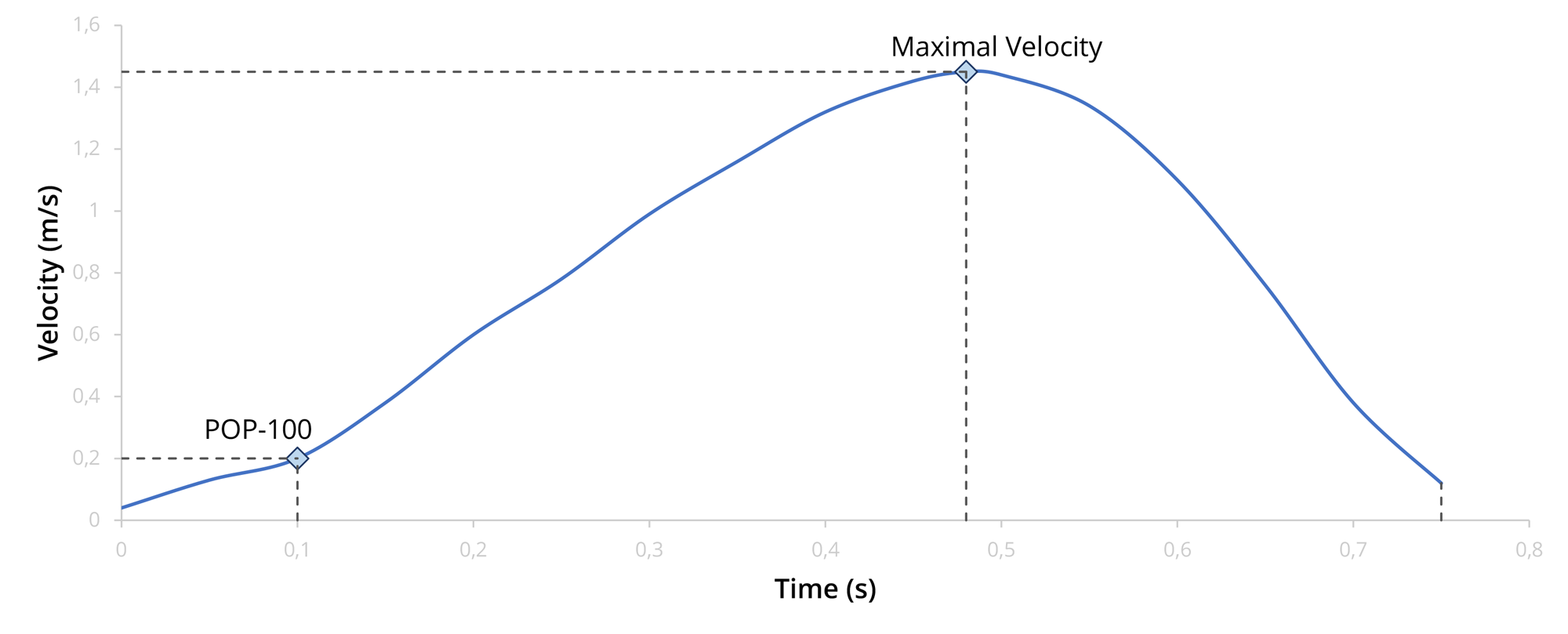
Figure 3. Bar velocity versus time during the concentric phase of a 60% 1RM deadlift.
Receiving feedback on its speed execution can also optimize the technique of performing a movement. When we only have the load as a reference, we don't necessarily seek to optimize its trajectory bar : the main objective in this case is to complete each repetition. On the other hand, when we imposes a double stress of load and speed, we are then forced to adopt a bar trajectory the most effective possible. These technical adaptations, which normally require a lot of time and practice, will then be done in a more natural way. However, it should be noted that the impact of a speed feedback on the technique of execution of a movement can be double-edged. This is the case for movements from weightlifting, the technical execution of which requires a sequencing of several motor actions in a very precise timing. Therein, Bryan Man's observations on the subject are instructive: Athletes often have a competitive nature, the mere fact of giving them a return on the speed of execution of their movements can lead to a counter-productive game of whoever will have the highest bar speed. The negative consequences of speed feedback on the technique of execution are then not very far, especially with the first pulls precipitated instead of being controlled during a ground bar work. So he advises, when working on weightlifting movements, to opt for the peak speed that does not induce this kind of drift.
In 2011, a New Zealand study sought to assess the impact of the speed feedback could have on athletic performance (Randell et al., 2011). To achieve this, thirteen professional rugby players were randomly divided into two groups, then all follow the same training in resistance training. For six weeks, players in the first group received immediate feedback on their execution speeds, while players in group 2 did not receive any. Tests of vertical and horizontal jumps, as well as sprint tests on 10, 20 and 30 m were carried out at the beginning and at the end of the intervention. At the end of the six weeks, the researchers found that athletes who received feedback on their speed of execution had, on average, much more progress than those who had not received one (Fig. 4).
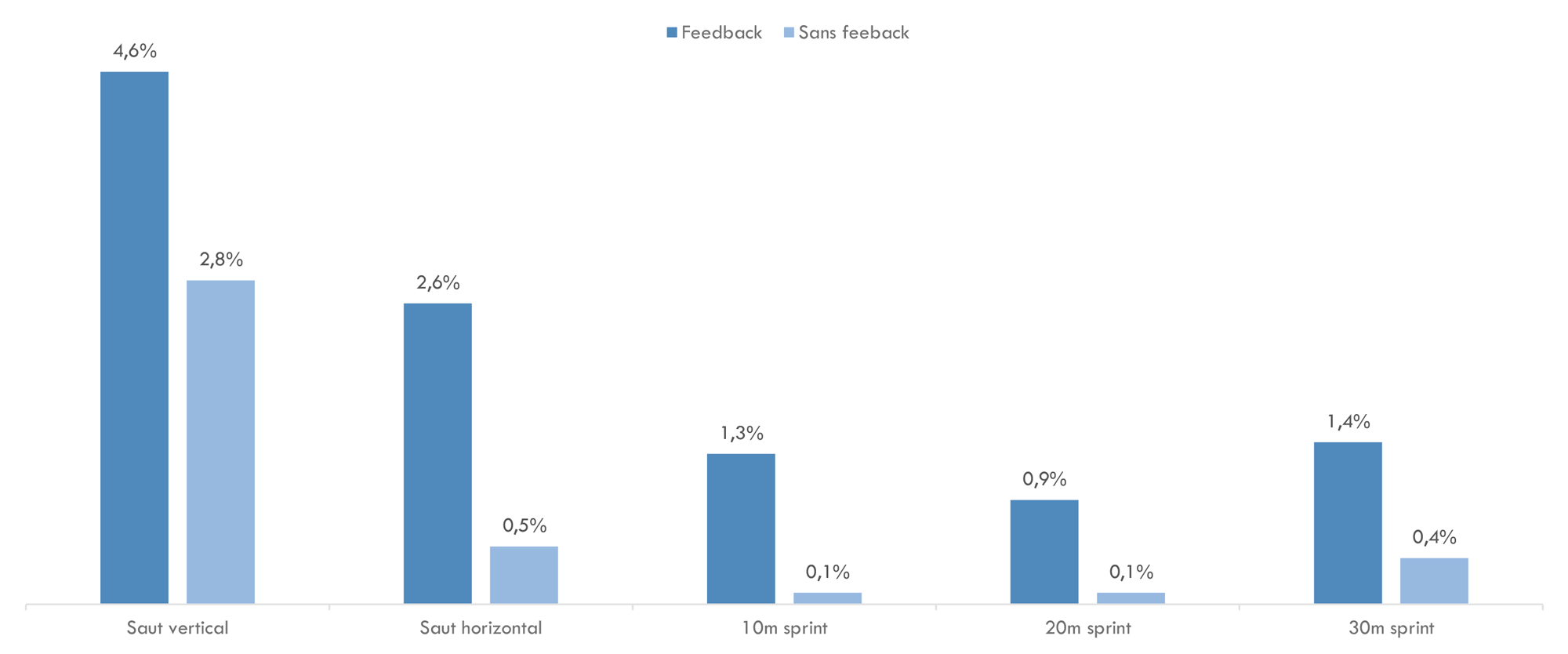
Figure 4. Progress comparison expressed as a percentage between group 1 that received speed of execution feedback (dark blue), and group 2 who did not receive it (light blue) (Randell et al., 2011).
Properly determining the intensity of an exercise is a fundamental aspect of strength training. Using a load too light will not induce the neuromuscular adaptations expected, while too heavy a load will compromise your ability to recover from one session to the next and will expose you to a higher risk of injury. In this part, we study two ways of determining a work intensity, from generic and specific Load-Velocity profiles. Let us first look at programming based on generic Load-Velocity profile, which is the simplest and fastest form of programming to implement. I use the term "generic" profile here because the information from which the work intensities are determined comes from averaged relative speeds. Historically, the first use of a generic profile for the work rate zone prescription was derived from the Bosco Force - Velocity continuum (Fig. 5).

Figure 5. Continuum Force–Velocity of Bosco.
Originally, the use of this continuum was meant to be relatively simple. Depending on the purpose of the day, we select the speed zone corresponding to the quality of force that we wish to develop. Once the speed zone is chosen, all that remains is to determine the load from an increasing range and to stick to this speed zone on each of the sets of the exercise (stopping its sets when leaving the area or reducing the load). However, some physical trainers have subsequently begun to use this Force - Velocity continuum inappropriately, considering it as a speed zone repertoire adaptable to any exercise. These zones of speed vary according to the chosen exercise. For example, if the mean concentric velocity reached on a squat at 100% 1RM is, on average, 0.25 m/s, this value approaches 0.15 m/s on a bench press. Our ability to generate strength at low speeds will depend on the exercise and therefore the muscle groups involved in the movement. The result of this observation is that each of the other relative velocity values also vary from one exercise to another. If we wishe to base our training on generic profiles, we must do so from profiles established on the exercise in question, as shown in Table 1.

The nomenclatures and definitions characterizing the different zones of speed (force - speed, speed - force, etc.) vary from one author to another, you are free to include them (or not) within each continuum as a function of your preferences. Such use of generic speed zones is practical because they do not require the execution of a 1RM test to be implemented. This method adapts perfectly to a beginner lifter. The main limitation of this approach comes from the slight variability that exists between each individual profile. Although this limitation does not preclude the use of this periodization method, an approach based on the use of individualized Load-Velocity profiles will increase precision in prescribing work intensities of more advanced lifters.
Now let's look at how to program strength training from individual Load-Velocity profile. The protocol described by Banyard et al. (2017a), below, will allow you to determine your 1RM and establish your Load-Velocity profile at the same time.
Incremental protocol for determining 1RM :
Note that this incremental protocol requires a preliminary estimation of your 1RM, in order to calculate the specific loads at each level. However, this protocol is provided as an example. Nothing prevents you from including additional load levels if you think you need it. On each repetition of the protocol, you must note the load and the speed reached for the same load. On the 20, 40 and 60% relative loads you are asked to perform three repetitions, remember only the fastest repetitions. Take three minutes of recovery between each series at intensities of 20, 40, 60 and 80% 1RM, then five minutes between each series corresponding to intensities of 80, 90 and 100% 1RM. Once your estimated maximum load is reached, decrease or increase this load by increment or decrement from 0.5 to 5 kg, always keeping 5 minutes of recovery between each test. Once your data is collected, all you have to do is add it to an Excel spreadsheet and perform a simple linear regression to obtain a complete mapping of your relative speeds (Fig. 8).
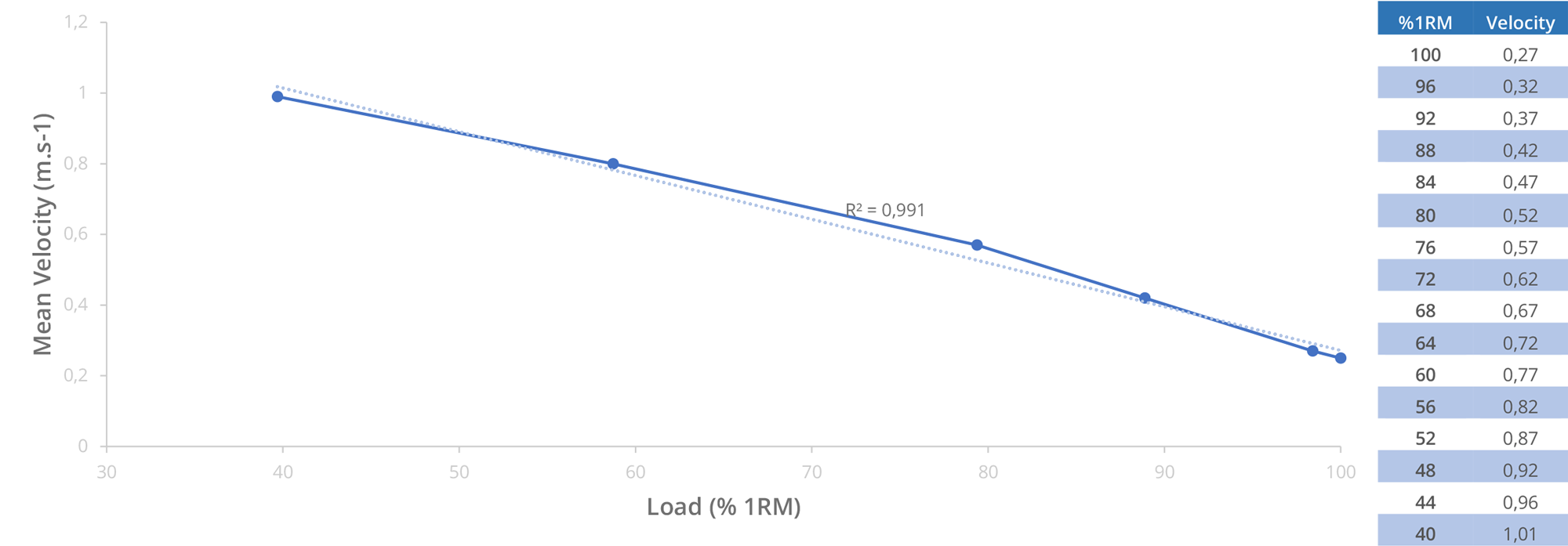
Figure 6. Load-Velocity profile obtained from an incremental protocol for determining 1RM squat. The dotted line represents the linear regression. The relative velocity values of the right panel were obtained from a linear regression.
To use your relative speed chart for programming purposes, you only need to prescribe your series based on a load in kg, but on a speed corresponding to the percentage of 1RM from which you want to work. The load will then be determined by the athlete on the day of the workout. The specific warm-up plays a major role in this method, as it will be used to determine the load of the day.
Example :
If the workout of the day corresponds to 3 sets of 8 repetitions at 70% 1RM at the squat, the athlete will then have to refer to his relative speed chart to determine his target speed. During his warm-up, he will have to find empirically what is the highest load with which he is able to reach this speed. Once the load is determined, the athlete can begin his training session.
The interest of the method is that the workout would be adapted to your daily fitness and not the opposite; the speed abilities being largely dependent on the level of freshness of the central nervous system. While this kind of test may seem longer and more complicated than a traditional 1RM test, the information you get from it to program the training has an almost unlimited lifespan. Indeed, as we have seen previously, if your 1RM is brought to change, your relative speeds will remain stable in time. Thus, the investment in time required to establish a Force-Velocity profile saves time in the long term, compared to a mode of operation based on a test of 1RM quickly obsolete. The only thing that I think would force you to update your profile would be either the change of your measuring device, or a very advanced training in a specific speed zone.
We have just seen how to select the right training load, and therefore how to regulate the intensity setting based on the information given by your Load-Velocity profile. Let's see now how it is possible to regulate its training volume. As in traditional programming, volume management will be done according to your objectives and especially the intensity of work. Two solutions are available to us when we want to regulate its training volume compared to its bar speed.
The first is to use a certain percentage of speed loss, which will determine when to stop the series or exercise. Few studies have examined the question, namely what is the ideal loss of speed beyond which each repetition carried out induces an unnecessary (or even counterproductive) fatigue when one wants to work on power, strength or hypertrophy. However, we can already set a basic framework for establishing percentage loss of speed, depending on the types of neuromuscular adaptation sought. Take the example of a workout whose main objective is to develop power capabilities. To maintain a state of freshness in the movement, it is necessary to limit the appearance of fatigue (Newton and Kraemer, 1994). It will then be possible to set a maximum speed loss threshold around 10 to 15% with respect to the fastest repetition. If the goal is to benefit from the nerve adaptations of a strength training without the structural adaptations (which can be interesting for a weight class sport), it will be necessary to direct you towards a percentage of loss of speed of 20% (Pareja-Blanco et al., 2017). According to the results of Sánchez-Moreno et al. (2017) and Gonzálles-Badillo et al. (2017), a loss of speed of 20% indicates that 39 to 45% of the maximum volume of repetition has been performed. On the contrary, if the training is intended to generate muscle hypertrophy, we can allow speed losses beyond 40% before ending the series. Knowing that allowing greater speed loss in the series also involves a higher repetition volume, and therefore more metabolic and structural damage inflicted on the muscles. However, allowing greater speed decrease when targeting hypertrophy does not mean training until muscle failure. Considering the results of a recent meta-analysis (Davies et al., 2016), showing the absence of significant additional force gain following training routinely leading to muscle failure, we are entitled to seriously reconsider this training modality. Thus, any athlete concerned with the intelligent management of his fatigue levels in relation to his competitive objectives, should be careful to carry out such sessions in a reckless way. The same goes for the simple lifter, even if in this case a mismanagement of the capital tiredness will bear less consequences. During training, we naturally try to create stress so that a repair and overcompensation process can be put in place. But all the difficulty lies in finding a compromise between the intensity of the stress and the recovery abilities of the athlete. Training systematically to fail is not to stop at a gas station when you are on the reserve, thinking that we will save time on the journey. This short-term vision of training is based on a biased conception of what is the efficiency of a workout, the only criterion of which is the maximization of fatigue levels. In the long run, training in failure will inevitably lead to a forced stop on the emergency band. In addition to exposing oneself to the physical risk of unbalancing the balance between efforts and recovery capacities, training systematically to failure can lead to the creation of mental barriers.
If you have repeated thoughts of failure, that’s what you’ll become. Instead I work hard and push myself a little bit further every time and then I stop. Why? Because it means that in my mind I don’t know what my actual max is, therefore, anything is still possible.
Brian Shaw
Of course, I'm not talking here about coming up with a 'programmed' failure, which is achieved at the end of a planned progression cycle. I speak of the muscular failure used as a systematic training strategy, when considered as an end in itself. However, it can be difficult to subjectively estimate how much RIR remains. The regulation of the training volume by a percentage of loss of speed comes up against a major practical limitation, because this method does not allow us to know this data. In addition, the number of repetitions performed for a given percentage of speed loss could depend on the selected load. For the same percentage of loss of speed, it is therefore possible that the levels of fatigue obtained vary according to the percentage of workload.
This brings me to the second way of regulating resistance training volume, from a bar speed and RM-Velocity profile. The principle of the RM-Velocity profile (RM for maximum repetitions) is similar to that of the Load-Velocity profile, with the difference that instead of associating relative loads with speeds during a 1RM test, we combine repetitions with speeds. Like the velocities of the Load-Velocity profile, each value of RM is associated with a speed that characterizes it and seems stable over time (Sánchez-Moreno et al., 2017; Jovanović and Flanagan, 2014). Regardless of the load used during a fail set, each speed value for a given RIR level will be substantially the same. So, whether you use 60% or 80% of your 1RM on a set to fail, you will get the same speeds when you only have 1, 2, 3, 4 or x RIR left. The advantage of the method is that at any time in your sets, you can accurately estimate your RIR level, and set minimum speed thresholds based on the number of repetitions you want to keep in reserve during the session. I usually call these minimum speed thresholds "fuse speeds", because they allow to stop the sets before the intensity of work becomes too great. RM tests are in practice faster to implement than 1RM tests but require an equal level of standardization to obtain reliable data. It will be essential to be very strict about the duration of inter-repetition rest, otherwise the variability of your recoveries will affect the linearity of your relationship. The use of a metronome can help you maintain a regularity in the duration of your inter-repetition rest. To perform your RM-Velocity profile, a workload located between your 12RM and 6RM (approximately 75 to 85% 1RM) is suitable.

Figure 7. RM-Velocity profile obtained from a maximum repetition (RM) protocol at 73% 1RM. The dotted line represents the linear regression.
Even though the work of García-Ramos et al. (2017) are encouraging about the reliability of the RM-Velocity relationship for RIR prediction, more research is needed to generalize their use. In terms of estimating fatigue, the use of individualized RM-Velocity profiles already seems more accurate, compared to the percentages of generic speed loss. However, speed loss percentages remain a good option when the physical trainer is in charge of programming the training of a sports team like in rugby, for which the setting up of test sessions can be extremely time-consuming.
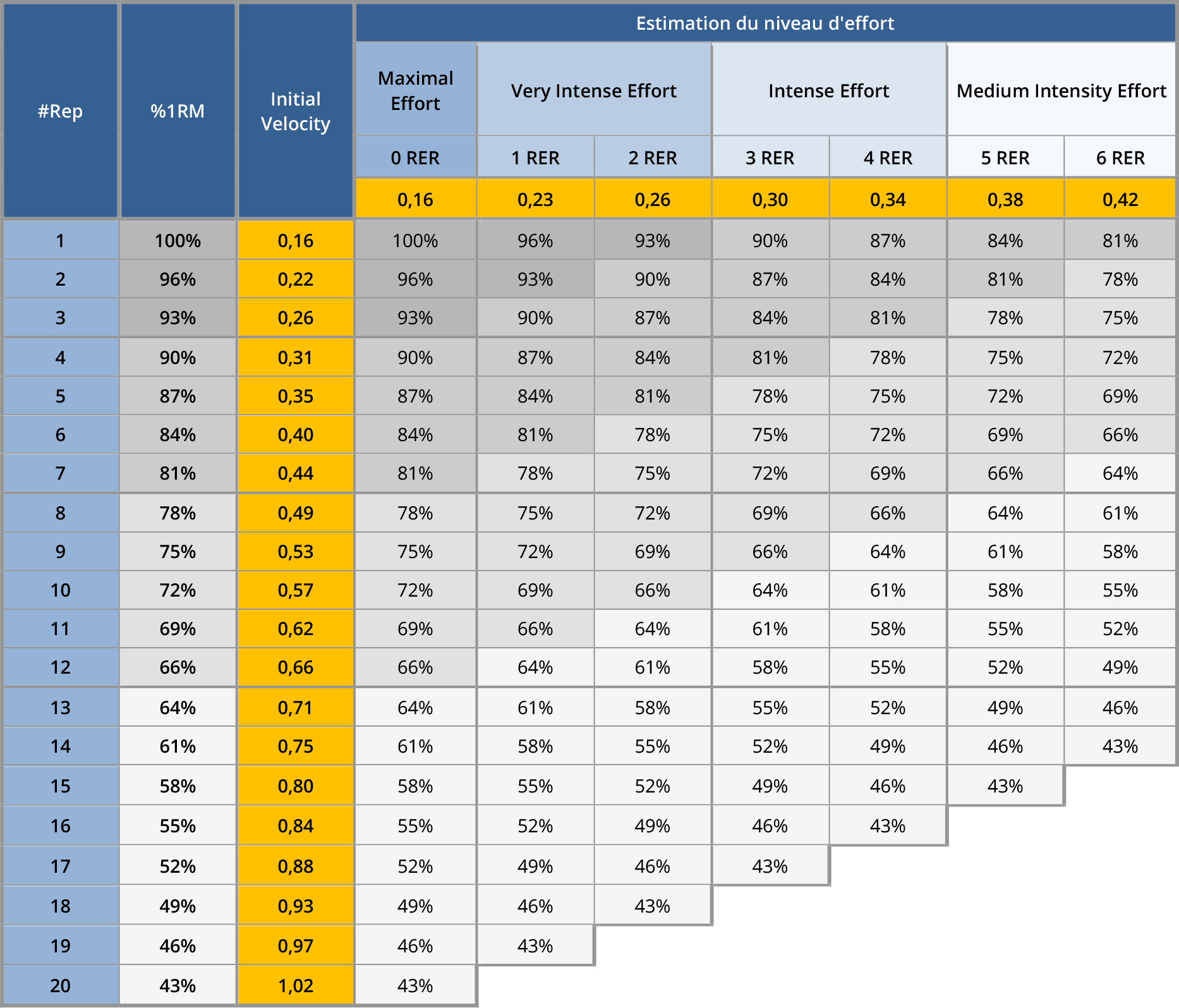
Figure 8. Table of estimation of the level of effort as a function of the relative load and the bar speed, established from a Load-Velocity and RM-Velocity profiles on a bench press (Jovanovic, 2014).
Figure 8 gives a clear example of what can be done from Load-Velocity and RM-Velocity profiles. This table may seem complex at first but let's take the time to analyze each part separately. The three left-hand columns correspond to the Load-Velocity profile information, matching each percentage of relative load with an initial velocity. The term initial velocity here designates the bar speed that can be expected to be achieved during the first repetition, for a given percentage of 1RM. The following three lines at the top of the table allow you to estimate a level of effort, and match the speeds of your RM-Velocity profile with a RIR level, as well as a description of the level of effort. The percentage values of the load below allow the deduction of work intensities according to the level of effort desired. Let us take again for the last time our example of programming composed of 3 sets of 8 repetitions at 70% of 1RM, whose last series must not exceed a level of effort lower than 3 RER. We therefore start by looking for the initial velocity value corresponding to 70% of 1RM, here 0.60 m/s. During the specific warm-up, the goal will then be to determine the highest load with which it is possible to reach 0.60 m/s. The minimum speed threshold corresponding to 3 RIR here is 0.30 m/s. In the end, we will have the following working format :
There are several types of devices to measure the speed of movement. I voluntarily leave aside the instruments used in the research laboratory because they are not necessarily practical and/or affordable. The devices of which we speak here belong either to the category of inertial sensors or to that of linear position transducers.
An inertial sensor is a measuring device that includes an accelerometer and a gyroscope, and that calculates the speed from the acceleration. With a relatively low cost (from 250 to 495 euros), these systems have the advantage of being wireless, and therefore extremely ergonomic. They can therefore adapt to almost all resistance training movements, and even some conditioning exercises such as battles ropes, sledgehammer, etc. These devices are usually associated with a modern and intuitive interface, which allows you to see in real time the speed of each of your repetitions directly on your smartphone or tablet.
The second type of system that interests us is the linear position transducers. Linear position transducers, which measure motion directly with a wire, are currently more accurate and reliable than inertial sensors for determining speed variables. Thus, the GymAwareTM or Tendo® are reliable measuring devices (Banyard et al., 2017b; Crewther et al., 2011; Garnacho-Castaño et al., 2015), frequently used by major rugby teams for the preparation of their players, and are sometimes even used as reference tools in scientific research. They also allow a fine analysis of motion kinematics, including the possibility to visualize the trajectory of the bar. However, they are not the most financially affordable (up to 2000 euros for this type of device).
Regardless of the type of measurement system chosen, the key to choosing your speed sensor is the validity of the measurement. Make sure that the device has been the subject of a validation study; and especially that this validation study was done on a non-guided polyarticular motion. The second element to take into account is obviously your budget. However, keep in mind that it is better not to integrate a practice based on bar speeds than to try to put it in place with poor measurement tools. Finally, your choice can be made according to the units of measurement offered by the different brands, and the quality of the interface they offer.
Is the integration of a speed sensor essential to progress in resistance training ? The answer is clearly no. Many athletes and coaches were training without in the past, and many of them will continue to do so for a long time. This is especially true if you have not yet reached an advanced level in weight lifting. Indeed, the addition of a speed sensor to the training involves an additional level of unnecessary complexity, in a phase where all the attention should be paid to the acquisition of basics patterns. The traditional periodization, coupled with the methods of subjective evaluation of the load, remains much simpler to set up and therefore still have beautiful years of training to come. However, the most experienced lifters will benefit from the integration of velocity based training concepts, giving them greater precision in programming, as well as the ability to regulate their training objectively. The integration of these concepts can also be considered hybrid way, borrowing both a traditional mode of operation and a mode of operation based on the speed of movement. This composite approach can be conceived both in the training periodization and in its regulation, by integrating only the strategies which seem you adapted to your needs. This can be a way to learn about velocity based training, by gradually mastering each of its aspects. Speed sensors can also be a great tool for individual fitness training or a sports team, as they can help refine the nature of physiological adaptations and manage athletes' fatigue daily. In addition, the interfaces of the measuring devices are not yet optimal in terms of functionality. Their future improvement should therefore facilitate the work of the lifter in the implementation of tests, storage of data and their interpretation.
 Clément Chery
Clément CheryWith a Master of Science degree in "Strength and Conditioning" obtained at Cardiff University, I specialized in physical training of sports with a dominant in strength and power. I am very interested in improving athletic performance, reathletization and nutrition. I keep updating myself in these fields.
We remind you that you can quote articles by limiting your quotation to 200 words maximum and you must include a nominative link to this one. Any other use, especially copying in full on forum, website or any other content, is strictly prohibited. In doubt, contact us.
Copyright © 2011-2024 - www.sci-sport.com - All rights reserved